The Rules of the Game
25 Aug 2006
Settle down, people; listen up. Listen up, settle down. Pay attention, you in the back. Let’s go over some rules here. We’re going to play a game.
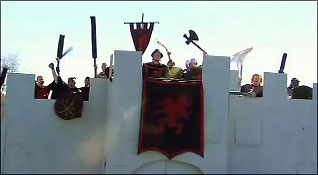
Darkon is a documentary about a live action role-playing game, the kind where you play a character, acquire powers, have battles, maintain a society, engage in trade, and develop relationships. But not online or with dice: you yourself actually go to a park with your tent, your costumes, your firewood and your gear, and live in that alternate reality. For an entire weekend, sometimes longer, you are your alter ego, you are only addressed by your game name and treated as your game identity. You might have a radically different role in the game society than in real life (warlord, wise woman, playboy, forest sprite), perhaps several; and for the time that you are there, you live that role(s). Then you go home and put away your secret identity until the next time, which may be only a few days or weeks away. After a while, or a level of commitment, what feels real and what feels like role-playing can shift, and your immersive identity can seem more real, or at least more meaningful, than your day job in some office. A day job which, most of us have to admit, seems very much like role-playing very much of the time.
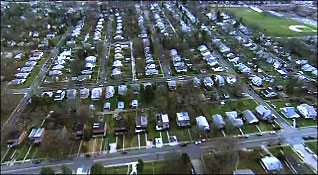
I’ve been interested in these alternative cultural spaces since I read Erik Davis’ article in The Village Voice in the early 1990s about the Klingon Empire, how certain Trekkies had invented their own language and armor and makeup and society, and lived in that created world, episodically, during Trek Conventions. Darkon the film, directed by Andrew Neel and Luke Meyer, explores Darkon the role-playing game, specifically a Darkon club near the Baltimore metropolitan area.
In real life we are not allowed to “play.” Or rather, we are, but the limits are very proscribed. Our games have very strict rules, and Rule #1 is: This Is Not A Game.
Neel first learned about Darkon while researching a script on Dungeons and Dragons, an earlier form of role-playing game. Live action role-playing games, or LARPs, are an active approach to being a fan. A garden-variety fan likes what he or she likes: the TV show, the movie, the book, the genre. We all do this, when we see a film, when we’re in an audience, when we read. Like right now. It’s fine, as far is it goes. But it doesn’t go very far. It’s a passive response to the material, you sit back and absorb, escaping into worlds someone else has created. Role-playing takes the opposite position. Instead of being passive, the role-playing fan takes the material and starts shaping it into something new. Using the characters, settings, conflicts and other details of the material, the fan creates new stories, and then acts them out to see where they go. It is a dynamic, creative, spontaneous position, something not at all like being an audience. But also, something considerably more than playing a role onstage.
In an email, Neel explained what drew him to LARPs in general and Darkon in particular:
“Virtual worlds. Life as performance. We are all charging the Quixotic windmills. I love that idea ... seeing humanity as this satirical mass of people chasing invisible things ... we all do that ... every day. The process of coming of age is the process of creating your character. You play this character every day of your life. Life is improvisational acting. Darkon is a wonderful way to investigate these elements of the human experience.”

At SXSW where the film premiered earlier this year, several Darkon players were in attendance. One of them also described LARPs to me as improvisational theater. Which they are. But they’re more than that too. In theater, even in the most intense method acting, the character is not sustained for more than a few hours. When performing, there is the audience to consider, there is the backstage area, there is the scenery and the lights and a hundred other reminders – for the actors, not just for the spectators – that this is “just” a play. But with immersive role-playing environments, there is no audience, everyone is there to participate. The reminders – soccer goals, telephone poles, minivans – are way off in the distance. And the play has no “end.” Sustained for several days at a time during events, the game itself doesn’t stop at the end of the weekend; it is merely put on “pause” until the next time. You pick up where you left off. This creates a commitment, a depth of character and a shared history that qualitatively moves the experience beyond the bounds of improv, and into the creation of culture itself.
When it works, a space like that is one of Hakim Bey’s Temporary Autonomous Zones (TAZ), a term first coined to describe Barbary Coast pirate societies. Within a TAZ, the theory goes, you are free(er) to invent your own categories of being, and to assume or try on or invent different identities, including but not limited to ones you’ve read about in books, ones you’ve seen on TV, ones you’ve imagined, and ones others have imagined; and collage them together in various combinations. A TAZ is outside conventional society but it is still social: crucially, you try out these roles along with others doing the same. (You can try this in your own head but then you’re either a novelist, insane, or just ineffective. A social space requires a society.)
Interestingly, this is not so very different from what we do in real life, except we’re not so autonomous. At least, we think not. The difference is really in scale and in the force of our assumptions about who we are, who we can be, and what we think we can do. In real life we have more cultural limits, many quite arbitrary and narrow. When is the last time you wore bunny ears to the grocery store (those of you not in San Francisco)? It’s a silly example, but it’s to the point: in real life we are not allowed to “play.” Or rather, we are, but the limits are very proscribed. Our games have very strict rules, and Rule #1 is: This Is Not A Game.
Or is it? Let’s examine the rules. First, the rules of film. In historical documentaries, you generally have several scenes of reenactments, where actors in costume perform, often silently, a short sequence of the event to be explained. These are included to illustrate a point and enliven the narration, and are not usually long or intense enough to draw you in. “Reality” in a documentary is the perspective of the voiceover narration, the presentation of the material by the outside, objective observer.
In a fictional or narrative film, scenes are presented in an immersive way, with their own internal reality. You suspend disbelief for an hour or two (or hope to if the film is any good), losing yourself in the actions of the characters onscreen. For the length of the film, the film presents its internal reality to you. “Reality” in a narrative film is the perspective of the characters.
Darkon is a documentary. But with a twist. Whenever the film showed characters “in-world” as they say, the scenes were not reenactments; they were presented from the perspective of the characters. But it didn’t go all the way toward fictional reality either. Darkon mixed the genres by alternating these passages of fictional immersion with the more conventional documentary perspective of voiceover narration and interviews. Is the film’s reality the perspective of the observer, or of the characters? Darkon doesn’t say. The juxtaposition sets up an unresolved tension between two very different, and mutually exclusive, film realities: fictional and objective, immersive and didactic, inside and out. The viewer could not be sure which one represented “the truth” in the film and which one the aesthetic response.
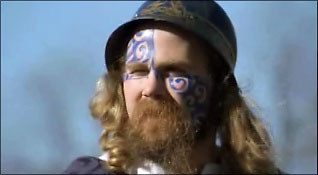
In choosing this course, the filmmakers were motivated by their clear sympathy for the subject matter. But the structural tension created by this choice became something more interesting than sympathy: it questioned the rules of the game. By giving different kinds of reality equal weight and not privileging one over the other, the film straddled two worlds. Darkon is outside of the objective, “god’s-eye view” perspective that documentaries usually assume. But neither is it fully inside, “in-world,” as it would be if the filmmakers had made a fictional narrative along the lines of Star Trek. Darkon-the-movie is in-between; it is in both places, and none. This suspension allows you to consider – where does reality lie for these characters? In their real lives, or in their role-playing ones?
This question took on greater importance for the filmmakers during production, as they attended nearly every Club event for over a year, and “embedded” themselves to better observe and shoot.
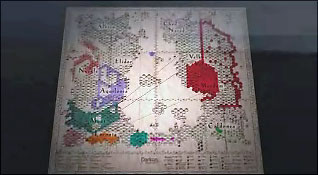
“During the filming we made a rule for ourselves that we would not play the game until the shooting was completed,” said Meyer. “Now that it is, we have joined the game and our production company (SeeThink) has formed as a country and we have land on the game’s map.” “Our god is the god of light (Lumieros),” added Neel. “All hail Lumieros keeper of the light and purveyor of truth!”
So let’s take it outside – of film theory that is. Out here, Darkon is still just a game. Everybody has jobs, homes, pays taxes, lives in the real world. Everybody knows they’re pretending. There are no medieval warriors, no forest sprites. Not even the most dedicated and immersed player believes that.
But those are the wrong answers. The question is not which is more real. The question is, where can you feel more like yourself? In your mid-level administrative job, worrying about getting downsized or meeting monthly quotas? In traffic? At a cocktail party? Watching TV? Fighting insomnia? Waking up to do it all over again? Or, do you feel more like yourself in the game, “in-world,” inhabiting a role you created, respected by the other gamers, being as quirky and individual and offbeat as you like, or being as standup and responsible and organized as you can, surrounded by people whose desire for meaning in everyday life has been so unmet that they were motivated to create an entire alternative society?
According to Meyer, “the idea of making up a new identity that you can put on and take off like a costume was fascinating, a character that is both separate [from] and closely connected to the person you actually are... And when you get into the idea that we are all role-playing in our day-to-day lives, changing bits and pieces of who we are to best fit each situation that we come in contact with, the whole concept becomes even more fascinating. You are not the same person at work that you are with your boyfriend or girlfriend, and the people you are in those situations are different than who you are with your parents. It all brings up questions about who each of us really is.”
The psychological and social rewards of living a meaningful life within a meaningful society are what motivates LARPers. What is so “real” about real life, they might ask, if it’s not giving us that?
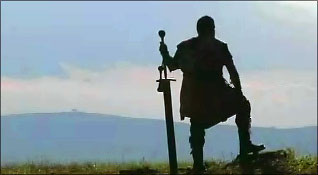
Perhaps “real life” can be more fictional, in that limits on our autonomy and freedom are based on incorrect and repressive assumptions about who and how we are. Perhaps “in-world” can be actually more real, in terms of recognizing individual and societal potential. In this way, Darkon mixes fact and fiction, and invites us to consider: who are we? How can we live? What can we create? Where can we be?
Darkon-the-movie questions the rules of film, similarly to how Darkon-the-game questions the rules of society. In its form as well as in its content, the film captures the game’s essential challenge: Rule #1: This Is Not A Rule. And in this game, that is reality.
Andrew Neel and Luke Meyer are currently working on a documentary about the painter Alice Neel. They can be reached at www.seethink.com.Peggy Nelson is an artist and filmmaker who writes occasionally for OtherZine. She can be reached at www.peggynelson.com.
◊